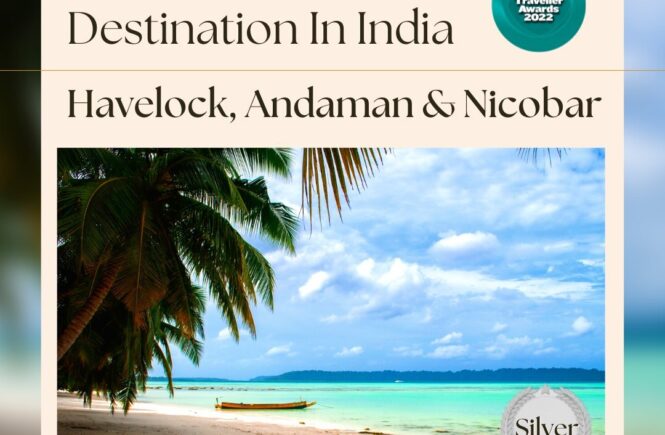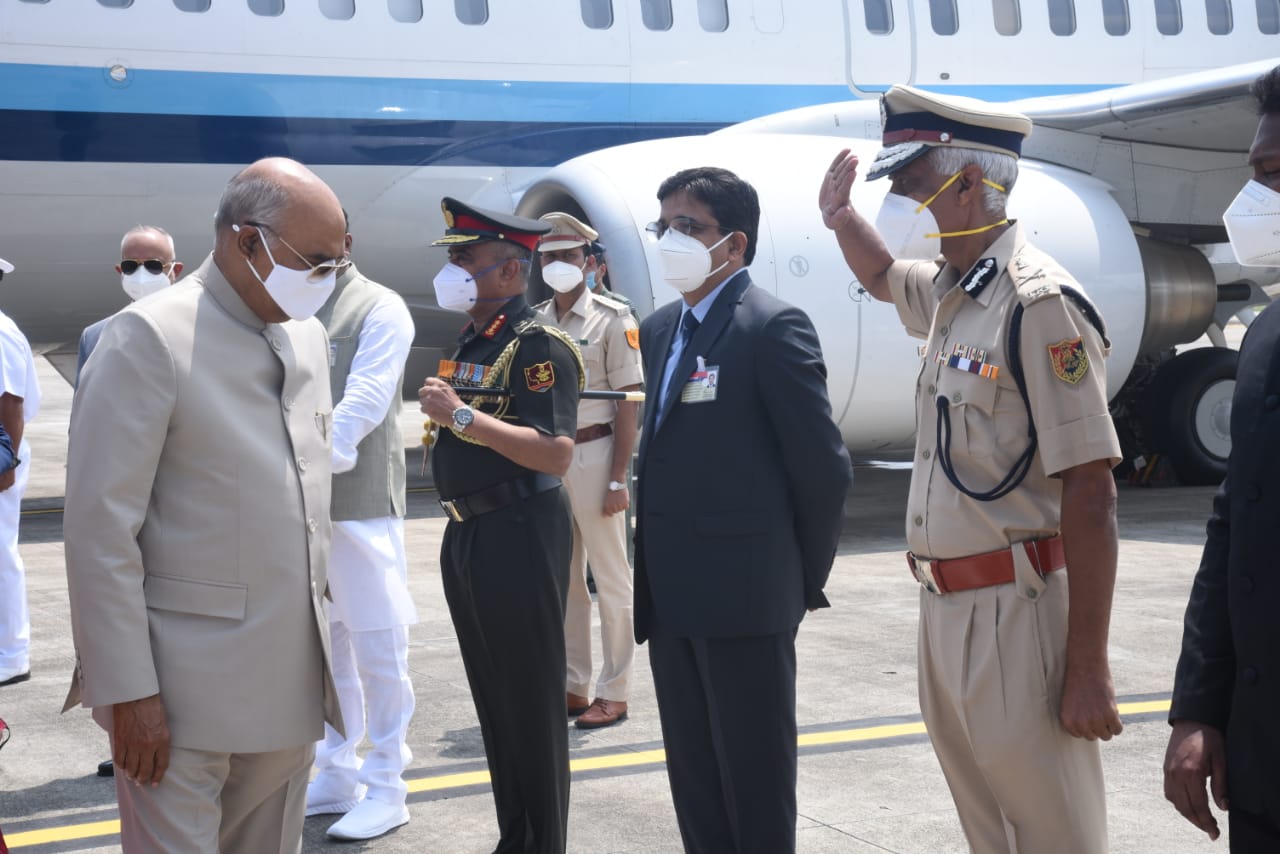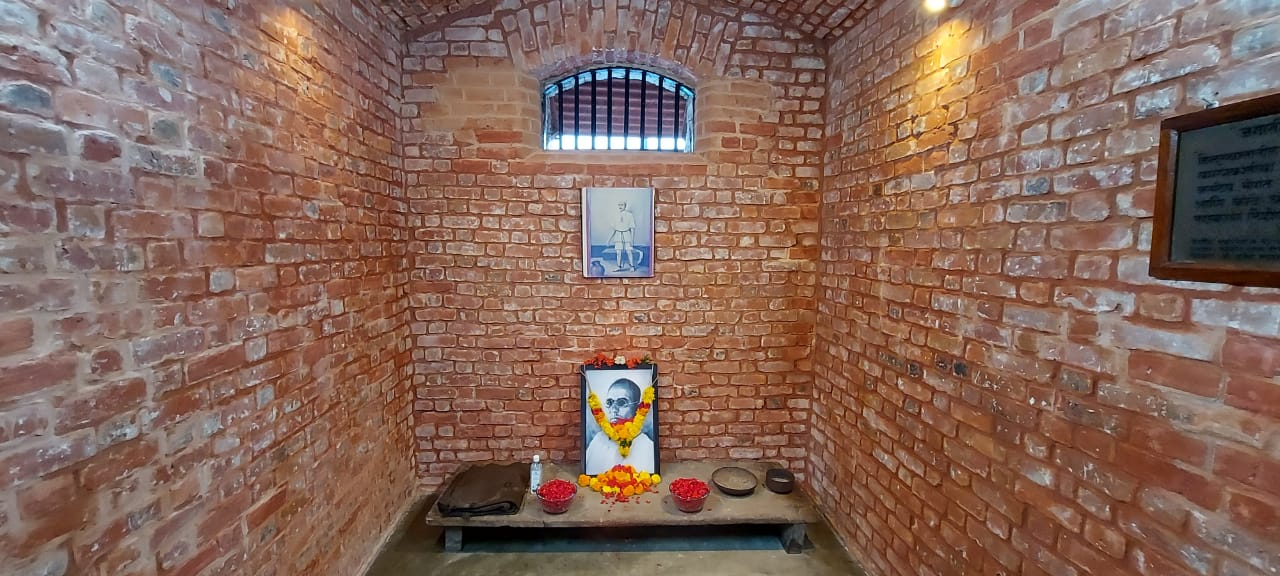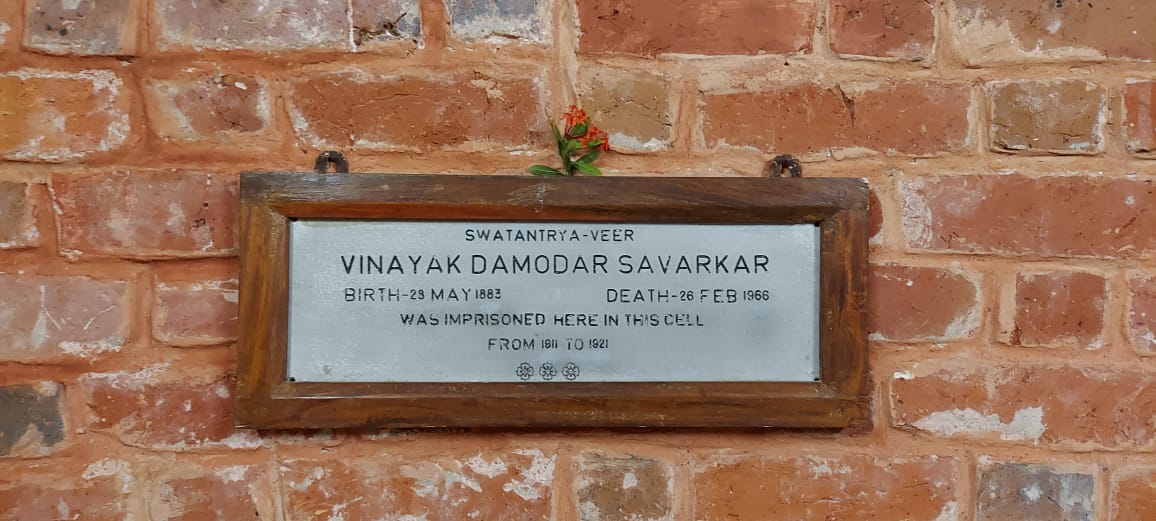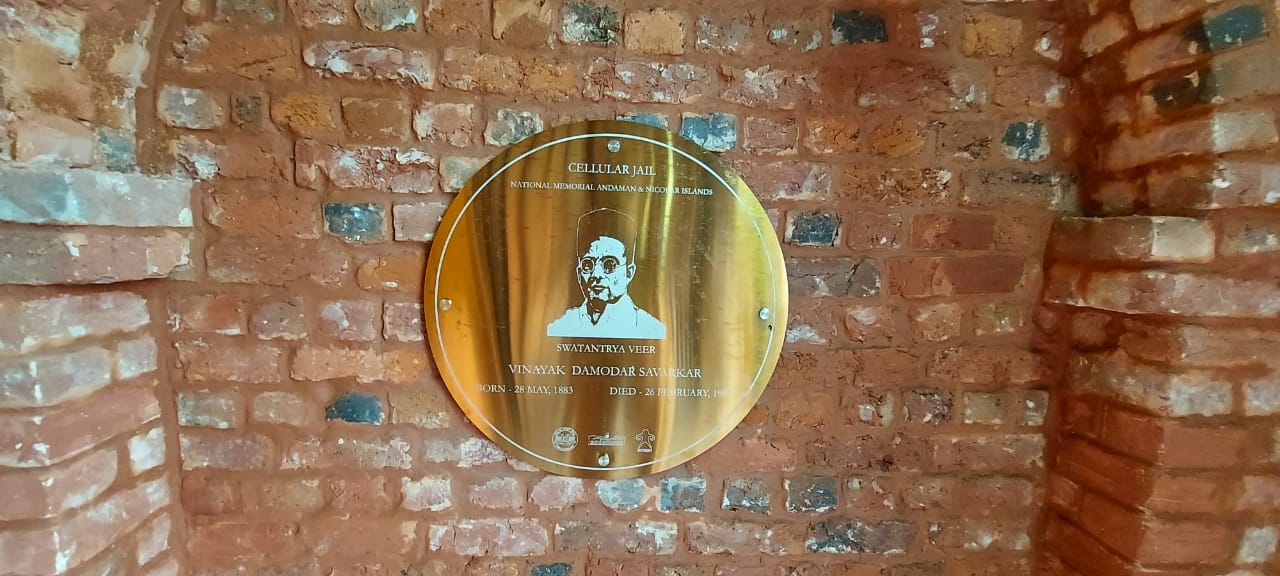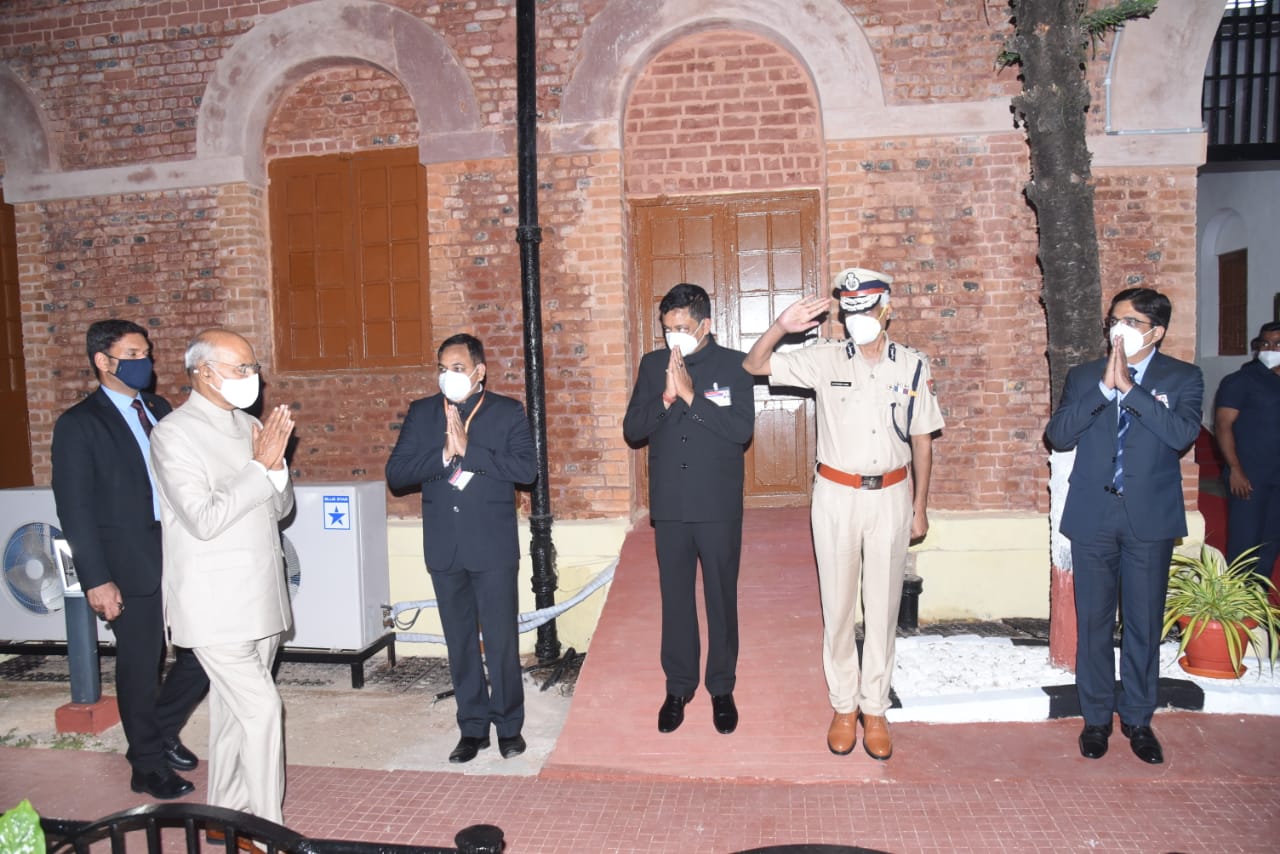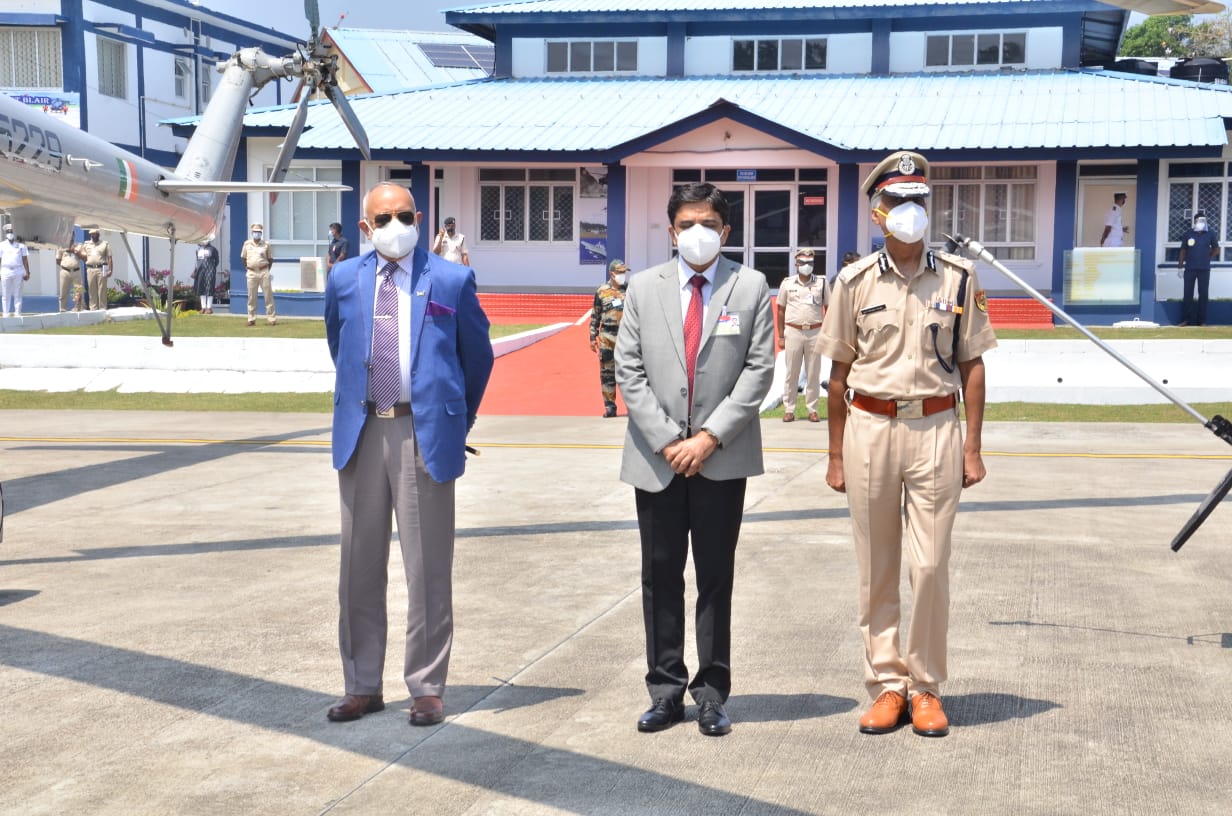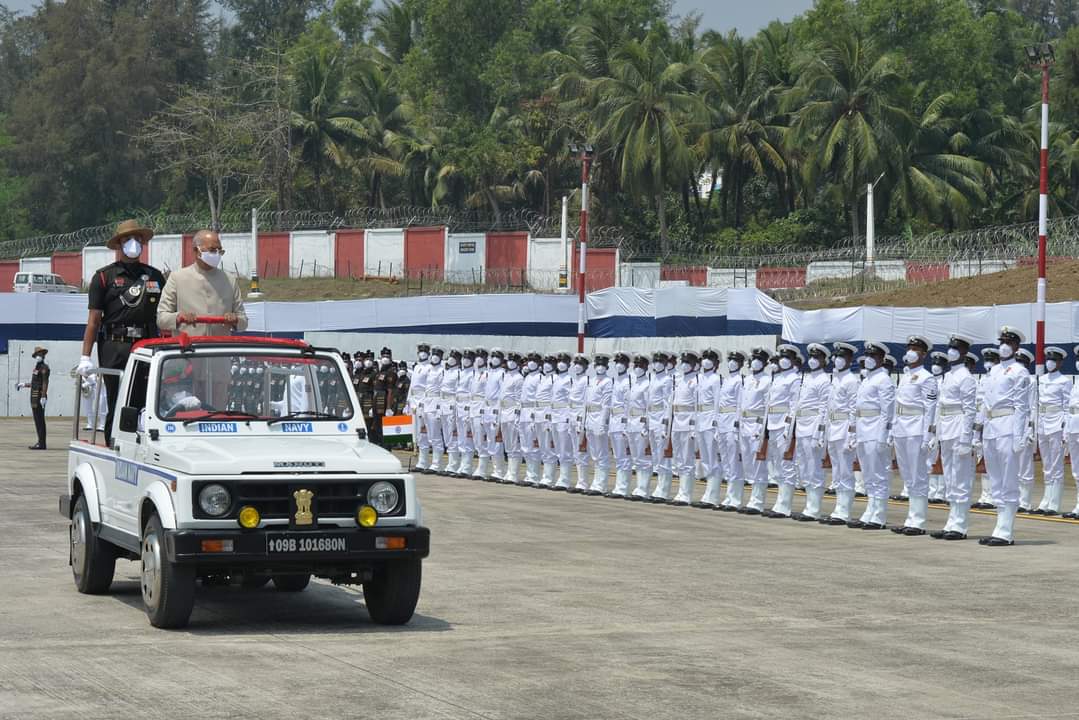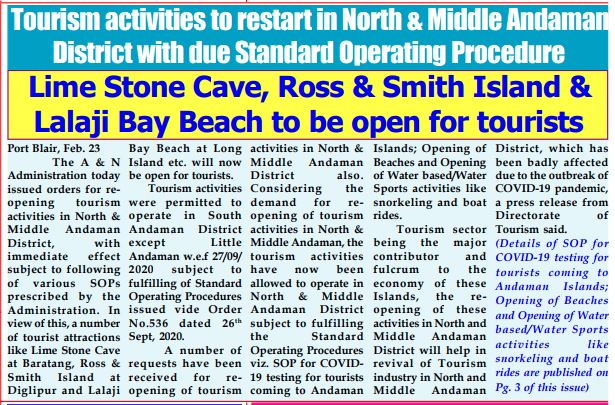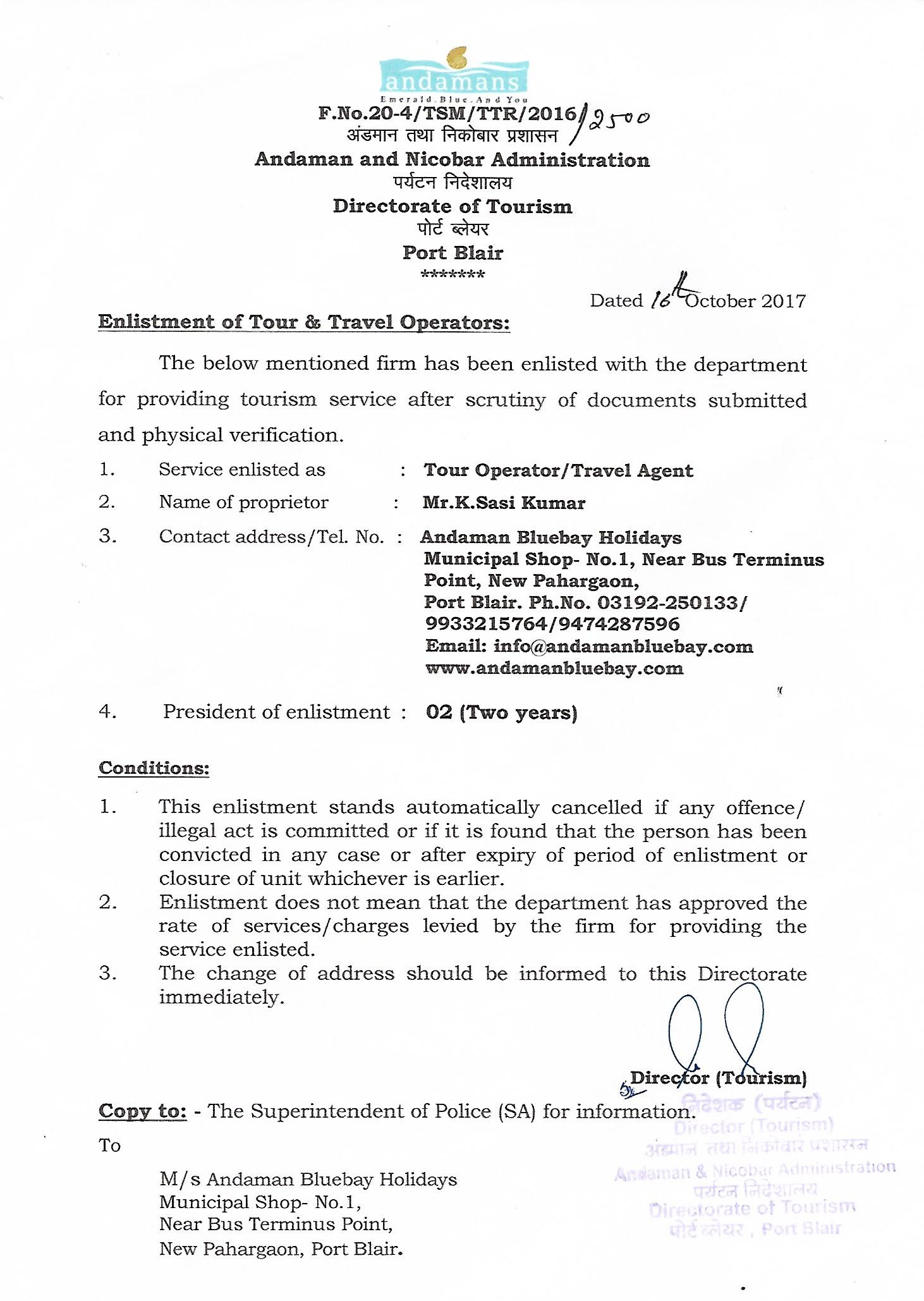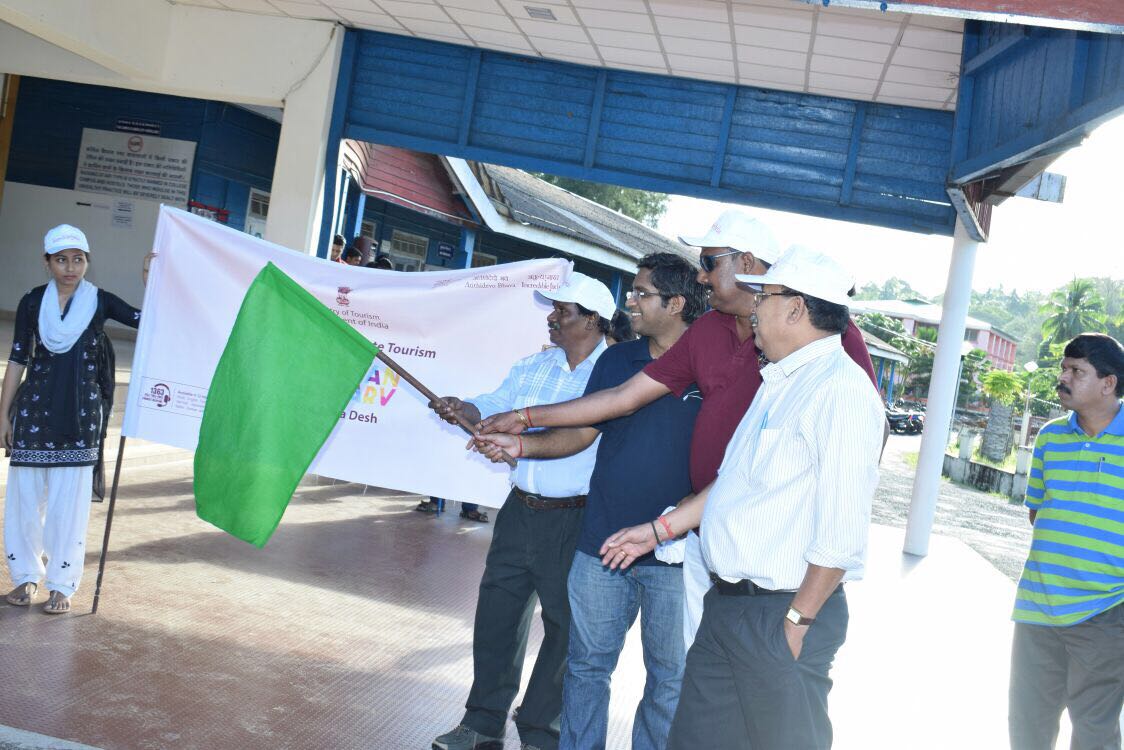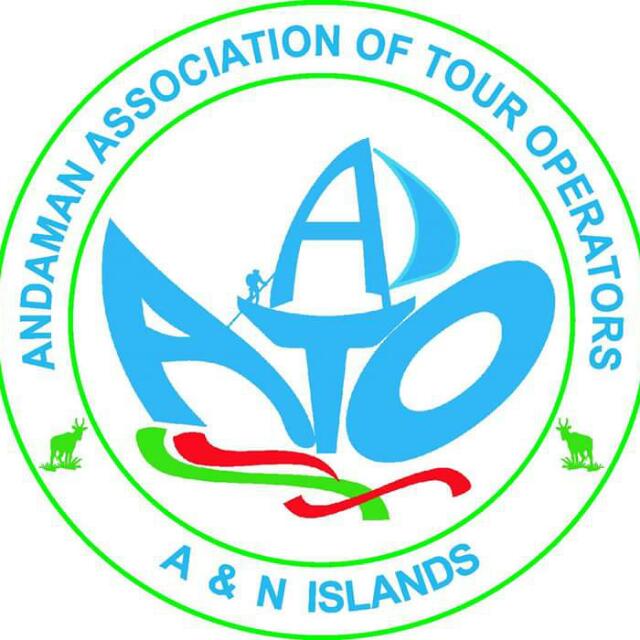1. The Tourism activities are permitted only in North & Middle Andaman District and South Andaman District except Little Andaman.
2. The beaches will remain open between 10.00 AM to 05.00 PM daily.
3.Tourists/visitors to maintain a minimum distance of 02 meters in public places / beaches.
4. Use of face cover / mask will be mandatory for all the people visiting the beaches.
5. Life Guards / TSET Members posted at various beaches to wear mask and hand gloves and take other required precautionary measures.
6. Spiting shall be strictly prohibited on the beaches.
7. Entrance gate of the beaches to have mandatory hand hygiene (sanitizer) and thermal screening provisions. Only asymptomatic staff and guests shall be allowed.
8. Tourists/visitors shall monitor their health report about any illness immediately to the Beach Officers/Life Guards and TSET Members.
9. Tourists/visitors shall dispose of face cover/masks/ cloves and other leftovers only in the dustbins.
10. Tourists / visitors should follow the directions of staff regarding crowd management at beaches.
11. Separate entry and exit for guests on the beaches to be organized, wherever feasible.
12. Group photography will not be allowed at the beaches.
13. Only authorized vendors to be allowed on the beaches.
14. Tourists/visitors should avoid overcrowding in the washroom area.
15. Tourists/visitors above 65 years will not be allowed.
16. Respiratory etiquettes to be strictly followed. This involves strict practice of covering one’s mouth and nose while coughing/sneezing with a tissue/ handkerchief/ flexed elbow and disposing off used tissues properly after use.
II. Standard Operating Procedure for Waterbased/Watersports
activities
A. General Standard Operating Procedure for Watersports
The following general measures and the specific step as listed out
herein are to be observed by all: Owner, Operator, Employees, Associations,
Agents, Guides and Guests- at all times. General measures are:
a) All Watersports/boating activities in containment zones shall remain closed and no operation shall be allowed.
b) It shall be made mandatory for guests and all those involved in operations to download, install and verify the status AarogyaSetu mobile application.
c) The Owner, Operator, Employees, Associations, Agents, Guides etc. Must subject themselves for thermal scanning at least twice in a day before commencement of the duties in the morning and upon completion of the operations in the afternoon/evening.
d) All Guests arriving at the booking counter/watersports center should be thermally scanned and the status ascertained on AarogyaSetu mobile app before the tickets are issued.
e) It is mandatory for all to wear the face-mask of stipulated standard all through and it should be enforced unfailingly.
f) Respiratory etiquettes to be strictly followed. This involves strict practice of covering one’s mouth and nose while coughing/sneezing with a tissue/ handkerchief/ flexed elbow and disposing off used tissues properly after use.
g) Sick or unwell guests to be immediately taken for check-up to nearest hospital in separate vehicle.
h) Booking of trips and allocation of slots should be planned to avoid unwarranted gathering of guests and adhere to social distancing norms.
i) Ensure that guests are taken in small groups to meet physical distancing norm of minimum 6 feet between guests and it should be strictly maintained. Any change in this norm should be in accordance to the Government norms from time to time.
j) Greet the guests with “Namaste” preferably with folded hands. Handshakes should be strictly avoided.
k) Agents and guides should carry sanitizer and wear mask.
l) Always carry extra face masks onboard to offer guest in case of emergency.
m) As per Ministry of Tourism stipulation, the Guides must handle group lesser than 10 guests. One dedicated person should be deployed for coordination of every group of maximum 10guests.
n) At ticket counters/booths, the staff etc. must wear the gloves and masks all through. In addition, face-shield for the counter-staff can also be considered.
o) Upon issuing the tickets, the guests should be given a detail brief on the do’s and don’ts during the operations, and it must be reminded frequently till the trip is over.
p) Employees handling ticketing and currency transactions are compulsorily to wear, face shield and to hand sanitize the hand frequently.
q) Maintain the hygiene standards.
B. Standard Operating Procedure for Boat owners
The following practices are to be strictly adhered to while taking guests
for boating trips. The following SOP stipulates practices at each stage/
facet and for specific stakeholders. The boat shall operate 50% passenger
capacity.
I. Before Boarding the Boat (While arriving at watersports Centre)
i. Boat Owners:
a) It must be ensured that all touch points in public areas like the ticketing counter, counter tops, boat jetty, onboard boat, door handles, levers, hand railings, etc. are cleaned frequently and at regular intervals every day using a sanitizer/disinfectant. It is advised to use Sodium Hypochlorite 1% solution having at least 70% alcohol to clean these frequently touched points.
b) The commonly used personal safety protection equipment’s like Personal Floatation Device (PFD) should not be reused without disinfecting.
c) Ensure that hand sanitizers are made available in sufficient numbers and quantity for disinfection facilities of visiting tourists/crew members at the booking counter/booking stations.
d) At ticket counter, if wash basin is not available, a water tank fitted with tap may be placed at safe distance from booking counter/station. Soap dispenser may be placed near the wash-basin.
e) Face masks and sanitizers should be made available to guests on demand.
f) Proper documentation of the guest in each trip for contact tracing must be enforced. Use of separate trip sheets for each trip must be a standard practice.
g) The trip-sheet should have details viz.: Guest name, their age, city of domicile, telephone, date and time of the trip etc. Trip-sheet must be duly signed by the escort and owner.
ii. Operator and Crew Members:-
a) To ensure all boat systems and engines function efficiently and all equipment and gears in full operating condition.
b) A boat operating with more than one staff, viz. the operator and crew/ helper must ensure the stipulated social distancing norms on-board also.
c) The boat and all gears in use must be cleaned and disinfected before commencement of the operation, after which, it must also be thoroughly wash-down. On completion of trips every day also, above safe procedure must be followed.
d) To ensure that sanitizers are used by the guests before boarding the vessel.
e) Maintain the hygiene standards.
iii.Duties and responsibilities of Guests
a) Vigilantly maintain the social distancing norms uncompromisingly.
b) Avoid sharing of items like in addition eatables, water bottles, toys and safety gear etc. Always wear hand-gloves.
c) Wash the hands frequently with soap for 20 – 30 seconds even if it is visibly not dirty.
d) Hand sanitizers should be used before and after use of safety gear.
e) Self-monitoring of health by all and reporting any illness at the earliest must be diligently practiced.
f) All guests must mandatorily to have AarogyaSetu mobile application downloaded installed and used frequently.
g) Maintain the hygiene standards.
II. While boarding the boat
i) Duties and Responsibilities of owners:-
a) Fix the queue markers as per distancing between norms in waiting areas and ensure the orders.
b) Ensure complete discipline and order during boarding and to avoid unwarranted heckling.
c) Ensure that all persons aboard are seated as per social distancing norms, wearing face masks, hand gloves etc.
d) Ensure all equipment’s are adequately disinfected before and after every use.
e) Maintain the hygiene standards.
ii) Duties and Responsibilities of Operator and Crew
a) It shall be mandatory on part of the operator and crew to ensure social distancing norms on-board.
b) It must be ensured that the hand gloves, masks and face shields are worn by the crew members, especially during the boarding and alighting.
c) The guest needing assistance during boarding and alighting should compulsorily wear face shield and hand gloves.
d) Specific seat should be allotted to each guest and they should not be allowed to change during the entire trip.
e) Maintain the hygiene standards.
iii) Duties and Responsibilities of Guests
a) Always allow the guests in front to move/board or alight first by maintaining social distancing norms.
b) Always wait for those in front to completely disembark the ramps during boarding/alighting before others are allowed.
c) Always walk in the walkways assigned and do not wander.
d) The guests should avoid touching the objects/ surfaces when it is not absolutely necessary.
e) Maintain the hygiene standards.
iv. During Ride- Duties and Responsibilities.
a) Proactive replenishment: Hand Sanitizers, Hand Gloves and Masks to
be available at the Guest waiting Area.
b) Supply sufficient disinfectants like sodium hypochlorite (1%) etc.
c) Maintain the hygiene standards.
a) Safe operation practices must be strictly followed.
b) Ensure that at no point during the trip, the guest should be allowed to change the seat or stand-up to avoid loss of balance and bodily contact.
c) If bodily contact was necessary, use hand sanitizers and clean hands properly.
d) Maintain safe speed so as to avoid any accidents or injury so that calling emergency services/help can be avoided.
e) Maintain the hygiene standards.
a) Always wear a face mask and do not sneeze or cough openly, instead use towels or folded elbow. While onboard, should not stand-up to avoid loss of balance and bodilycontact.
b) To remain seated only at the assigned seat throughout the trip.
c) Maintain the hygiene standards.
III. While Alighting-Duties and Responsibilities.
1) Owners, Operators and Crew:
a) Ensure that the Jetty or marina area is not crowded. Complete discipline must be adhered to.
b) Incoming boats should wait for their turn to use jetty/marina until all boats are cleared of fit.
c) Maintain the hygiene standards.
a) Guest should vacate/disembark from boat by following social distancing norms.
b) Remove safety gears and also sanitize the hands thereafter.
c) Dispose of the disposables only at designated bins/containers.
d) Maintain the hygiene standards.
C. Standard Operating Procedure for Snorkeling
All Standard Operating Procedure mentioned above is to be complied with by the Operators/Crew members/Association/Agents and Guests. However, additional measures/precautions to be taken on certain activity specific watersports such as Snorkeling which are as follows:-
i) Before entering the water:-
a) The Snorkeling Guide shall brief the guests on the importance of maintaining social distancing and operations of snorkelling.
b) The Guests should have complete personal snorkelling kit full face mask. Only such guests should be allowed to undergo the rides.
c) No Snorkeling equipment’s shall be hired, borrowed, lent or shared even among members of the same family.
d) Only 02 guests per Guide must be allowed to snorkel at a time.
e) All guests must compulsorily wear face masks and hand gloves until entering the water and upon leaving the water-body.
f)At no point should the snorkelling guide touch any guest’s snorkelling equipment’s. All demonstrations must be given using own equipment’s.
a) Demonstrate snorkeling skills in thigh-level water, maintaining social distancing norms.
b) All guests must wear a life jacket before entering the water.
c) Use Lifebuoy with rope to tow the guests while snorkeling.
iii) After leaving the water:-
a) The safety gears such as Life Jacket and Life-buoy used by the guests must be rinsed, dried and disinfected before the next use.
b) The snorkeling equipment used by the guide must be kept at possession at all times to avoid accidental usage by other guides. The Guide must be diligent on this practice.
c) To ensure that the snorkel guide should mark all personal snorkeling kit with paint so that other persons may not use the same.
D. Emergency Response Procedure
As we all are aware of the fact that Watersports/water based activities have inherent risk factor involved, therefore as part of precautionary measures the following preparedness is to be kept ready by the owner/operator/crew:-
a) As a matter of practice, the Operator or Crew shall not disobey physical distancing norms unless any life-threatening emergency situation emerges.
b) The Operator must call for Emergency Medical Service (EMS) from the boat, and with the victim, immediately rush to the shore.
c) Assess the condition of patient till the emergency medical service arrives for help. If possible, ask the family or friend of the patient to aid the patient as per qualified First Aider instructions.
d) When EMS arrives, brief the professional medical person about the condition and First Aid provided to the patient.
e) If the PPE kit is available at Watersports center, the qualified First Aider must wear the same to perform First Aid till the time EMS arrives.
II. Over board Emergency:-
a) During Man Over-board situation, the boat operator and crew must follow the standard MOB procedure to rescue thevetin.
b) All boats in operations must carry a boat embarkation ladder/scramble net and extra rope 14 mm and 15 meters length.
c) To rescue the conscious victim on-board, the life guard/crew must give correct instructions to climb the ladder and to get on-board. If the victim requires support, provide step-by-step instructions to the family members
or friends of the victim to assist him/her.
d) If the victim is unconscious in water, use spinal board/ back board to mobilize the victim from water and recover him on-board.
e) Once the victim is on-board, qualified First Aider must do complete assessment of victim for response. If the victim does not respond, i.e. No breath or No Pulse, contact EMS immediately and rush the victim to the shore. If possible, commence the CPR procedure onboard. Else, administer the CPR procedure immediately after reaching the shore and securing the
III. Cardio Pulmonary Resuscitation:-
a) If the Victim is not responding, the qualified CPR aider must wear PPE kit and gloves before commencing of chest compression. Continue chest compression at the rate of 100 per minute.
b) Emergency breathing must be given only with AMBU bag, mouth to mouth resuscitation is strictly forbidden.
c) Continue the procedure till the Emergency Medical Service arrives or the victim is handed over to a medical professional.



